Related Research Articles

R Monocerotis, abbreviated R Mon, is a very young binary star system in the equatorial constellation of Monoceros. The apparent magnitude of R Mon varies between 10 and 12 and the spectral type is B8IIIe.
Gliese 86 is a K-type main-sequence star approximately 35 light-years away in the constellation of Eridanus. It has been confirmed that a white dwarf orbits the primary star. In 1998 the European Southern Observatory announced that an extrasolar planet was orbiting the star.
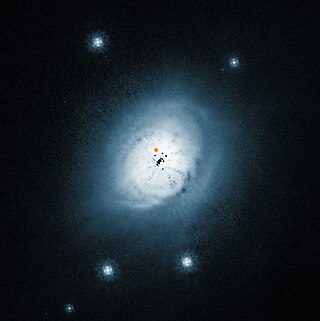
HD 100546, is a star 316.4 light-years from Earth. It is orbited by an approximately 20 MJ exoplanet at 6.5 AU, although further examination of the disk profile indicates it might be a more massive object such as a brown dwarf or more than one planet. The star is surrounded by a circumstellar disk from a distance of 0.2 to 4 AU, and again from 13 AU out to a few hundred AU, with evidence for a protoplanet forming at a distance of around 47 AU.
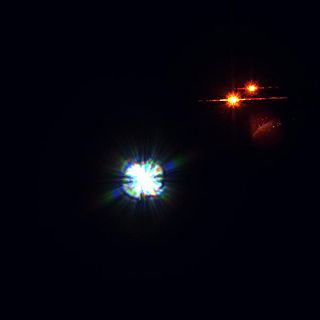
HD 141569 is an isolated Herbig Ae/Be star of spectral class A2Ve approximately 364 light-years away in the constellation of Libra. The primary star has two red dwarf companions at about nine arcseconds. In 1999, a protoplanetary disk was discovered around the star. A gap in the disk led to speculation about a possible extrasolar planet forming in the disk.
XO-2 is a binary star. It consists of two components: XO-2S and XO-2N.
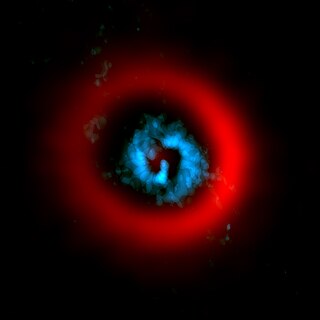
AB Aurigae is a young Herbig Ae star in the Auriga constellation. It is located at a distance of approximately 531 light years from the Sun based on stellar parallax. This pre-main-sequence star has a stellar classification of A0Ve, matching an A-type main-sequence star with emission lines in the spectrum. It has 2.4 times the mass of the Sun and is radiating 38 times the Sun's luminosity from its photosphere at an effective temperature of 9,772 K. The radio emission from the system suggests the presence of a thermal jet originating from the star with a velocity of 300 km s−1. This is causing an estimated mass loss of 1.7×10−8 M☉ yr−1.

HD 142527 is a binary star system in the constellation of Lupus. The primary star belongs to the Herbig Ae/Be star class, while the companion, discovered in 2012, is a red dwarf star or accreting protoplanet with a projected separation of less than 0.1″. The system is notable for its circumbinary protoplanetary disk and its discovery has helped refine models of planet formation. The orbit of companion is strongly inclined to the circumbinary protoplanetary disk.
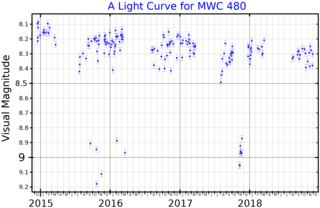
MWC 480 is a single star, about 500 light-years away in the constellation of Auriga. It is located in the Taurus-Auriga Star-Forming Region. The name refers to the Mount Wilson Catalog of B and A stars with bright hydrogen lines in their spectra. With an apparent magnitude of 7.62, it is too faint to be seen with the naked eye.

HD 259431 is a young stellar object in the constellation of Monoceros.

LkCa 15 is a T Tauri star in the Taurus Molecular Cloud. These types of stars are relatively young pre-main-sequence stars that show irregular variations in brightness. It has a mass that is about 97% of the Sun, an effective temperature of 4370 K, and is slightly cooler than the Sun. Its apparent magnitude is 11.91, meaning it is not visible to the naked eye.
HD 74389 is a double star system approximately 425 light years from Earth. The primary, HD 74389 A, was initially listed in the Hipparcos catalog as an A0V spectral type star, but this was subsequently updated in 1990 as A2V when Sanduleak and Pesch imaged it with the Burrell Schmidt telescope at Kitt Peak.

PDS 70 is a very young T Tauri star in the constellation Centaurus. Located approximately 370 light-years from Earth, it has a mass of 0.76 M☉ and is approximately 5.4 million years old. The star has a protoplanetary disk containing two nascent exoplanets, named PDS 70b and PDS 70c, which have been directly imaged by the European Southern Observatory's Very Large Telescope. PDS 70b was the first confirmed protoplanet to be directly imaged.

HD 36112 is a Herbig Ae star located in the constellation Taurus and the young star is surrounded by irregular rings of cosmic dust. The system is about 3.5 million years old. The disk has a cavity at 50 astronomical units and two spiral arms at 30-75 au that are seen in near-infrared scattered light, but only one spiral arm is seen in ALMA images.

DS Tucanae is a binary star system 144 light years away in the constellation of Tucana. It has an apparent visual magnitude of 8.5, and is a RS Canum Venaticorum variable. The system is notable for being young as a member of the 45 Myr old Tucana-Horologium moving group and for the primary star hosting the confirmed exoplanet DS Tucanae Ab, discovered by THYME, using TESS.
HD 155448 is a quintuple star system consisting of 5 young B-type stars. With an apparent magnitude of 8.72, it is too dim to be visible with the naked eye.

BP Tauri is a young T Tauri star in the constellation of Taurus about 416 light years away, belonging to the Taurus Molecular Cloud.

HD 150193 is a binary star system in the constellation of Ophiuchus. The primary star was identified as a Herbig Ae/Be star with a strong solar wind, losing approximately a tenth of solar mass per million years. It does host a very small debris disk, likely due to disk truncation by the nearby stellar companion. The disk is inclined 38±9° to the plane of sky. It appears to be highly evolved and asymmetric, with indications of flattening and grains growth.
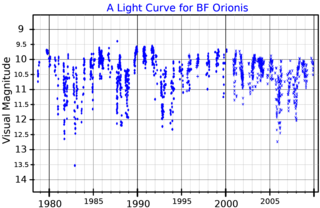
BF Orionis is a young Herbig Ae/Be star in the constellation of Orion about 1250 light years away, within the Orion Nebula. It is the most massive star of the small birth cluster of four stars.
HD 100453 is a binary star system which lies in the constellation Centaurus about 350 light years away from the Sun and is a member of the open cluster Scorpius–Centaurus association.

CQ Tauri is a young variable star in the equatorial constellation of Taurus. It is too faint to be visible to the naked eye with an apparent visual magnitude that ranges from 8.7 to 12.25. The distance to this star is approximately 487 light years based on parallax measurements, and it is drifting further away with a radial velocity of ~23 km/s. It appears to be part of the T-association Tau 4. CQ Tauri lies close enough to the ecliptic to undergo lunar occultations.
References
- 1 2 3 4 5 6 7 8 9 10 Vallenari, A.; et al. (Gaia Collaboration) (2022). "Gaia Data Release 3. Summary of the content and survey properties". Astronomy & Astrophysics . arXiv: 2208.00211 . doi: 10.1051/0004-6361/202243940 . Gaia DR3 record for this source at VizieR.
- 1 2 "SAO 206462". SIMBAD . Centre de données astronomiques de Strasbourg . Retrieved 26 December 2016.
- ↑ Guzmán-Díaz, J.; Mendigutía, I.; Montesinos, B.; Oudmaijer, R. D.; Vioque, M.; Rodrigo, C.; Solano, E.; Meeus, G.; Marcos-Arenal, P. (2021), "Homogeneous study of Herbig Ae/Be stars from spectral energy distributions and Gaia EDR3", Astronomy & Astrophysics, 650: A182, arXiv: 2104.11759 , Bibcode:2021A&A...650A.182G, doi:10.1051/0004-6361/202039519, S2CID 233393918
- ↑ http://informe21.com/ciencia-tecnologia/nasa-capta-fotografia-sao-206462-primera-estrella-forma-espiral La NASA capta una fotografía de SAO 206462, la primera estrella con forma espiral] Archived 2016-03-04 at the Wayback Machine . Informe21.com, 3 November 2011
- ↑ https://science.nasa.gov/science-news/science-at-nasa/2011/31oct_spiralarms/ 31 October 2011. Nasa Science.
- ↑ Grady, C. A.; Schneider, G.; Sitko, M. L.; Williger, G. M.; Hamaguchi, K.; Brittain, S. D.; Ablordeppey, K.; Apai, D.; Beerman, L.; Carpenter, W. J.; Collins, K. A.; Fukagawa, M.; Hammel, H. B.; Henning, Th.; Hines, D.; Kimes, R.; Lynch, D. K.; Ménard, F.; Pearson, R.; Russell, R. W.; Silverstone, M.; Smith, P. S.; Troutman, M.; Wilner, D.; Woodgate, B.; Clampin, M. (2009). "Revealing the Structure of a Pre-Transitional Disk: The Case of the Herbig F Star SAO 206462 (HD 135344B)". The Astrophysical Journal. 699 (2): 1822. Bibcode:2009ApJ...699.1822G. doi:10.1088/0004-637X/699/2/1822. S2CID 9298646.